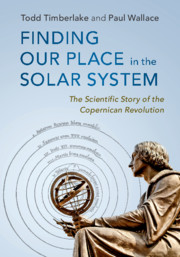Book contents
- Frontmatter
- Dedication
- Contents
- Preface
- 1 Introduction: mysterious skies
- 2 Two spheres: modeling the heavens and the Earth
- 3 Wanderers: the Moon and the planets
- 4 An Earth-centered cosmos: astronomy and cosmology from
- 5 Moving the Earth: the revolutions of Copernicus
- 6 Instruments of reform: Tycho’s restoration of observational
- 7 Physical causes: Kepler’s new astronomy
- 8 Seeing beyond Aristotle: Galileo’s controversies
- 9 The system of the world: Newton’s universal physics
- 10 Confirming Copernicus: evidence for Earth’s motions
- Appendix Mathematical details
- Notes
- References
- Index
7 - Physical causes: Kepler’s new astronomy
Published online by Cambridge University Press: 18 March 2019
- Frontmatter
- Dedication
- Contents
- Preface
- 1 Introduction: mysterious skies
- 2 Two spheres: modeling the heavens and the Earth
- 3 Wanderers: the Moon and the planets
- 4 An Earth-centered cosmos: astronomy and cosmology from
- 5 Moving the Earth: the revolutions of Copernicus
- 6 Instruments of reform: Tycho’s restoration of observational
- 7 Physical causes: Kepler’s new astronomy
- 8 Seeing beyond Aristotle: Galileo’s controversies
- 9 The system of the world: Newton’s universal physics
- 10 Confirming Copernicus: evidence for Earth’s motions
- Appendix Mathematical details
- Notes
- References
- Index
Summary
Johannes Kepler was working as a mathematics teacher in Austria when he had a vision of how the universe must be constructed. Using the Copernican system as his model, Kepler thought that between each planetary orbital sphere was nested a regular polyhedron. There are only five regular polyhedra, so there could be only six planets. The relative sizes of the planetary orbits were set by the shapes that lay between them. Kepler’s idea caught the attention of Tycho Brahe and eventually he became Tycho’s assistant. When Tycho died, Kepler inherited Tycho’s accurate planetary data and he used these data to propose a new theory of planetary motion. Kepler found that the planets move in elliptical orbits with the Sun at one focus of the ellipse. Furthermore, Kepler believed the motion of the planets was powered by a force from the Sun that caused the planets to speed up when closer to the Sun and slow down when farther away. Kepler also discovered a curious mathematical relationship between the orbital periods of the planets and the size of the planetary orbits.
Keywords
- Type
- Chapter
- Information
- Finding our Place in the Solar SystemThe Scientific Story of the Copernican Revolution, pp. 175 - 210Publisher: Cambridge University PressPrint publication year: 2019



